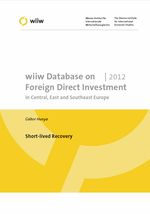Short-lived Recovery
Gabor Hunya and Monika Schwarzhappel
wiiw FDI Report No. 2012-05, May 2012
142 pages including 109 Tables and 8 Figures
Content
- New coverage:
- Kazakhstan
- Turkey
- The first part of the publication contains an analysis of the latest FDI trends.
The analysis highlights the temporary recovery of FDI in 2011. - The second part of the publication contains two sets of tables:
- Tables I: total flow and stock data, FDI flow by form and FDI income, FDI per capita and other FDI reference parameter (2003-2011)
- Tables II: detailed FDI data by economic activity and by country (last four years)
The main sources of data are the central banks of the individual Central, East and Southeast European countries.
General Description (PDF)
Abstract
FDI continues to be of great significance for the development of the former transition economies. The domestic engines of economic growth are still weak, and fiscal consolidation provides a drag on the economies. The short-lived recovery in 2011 was based mainly on external demand, which upgraded the importance of foreign investors, as they generate a major part of exports.
The first part of this report, following detailed methodological explanations of FDI related terminology, provides an analysis of the latest FDI trends in 22 CESEE countries. The strongest growth in FDI in 2011 was observed in the SEE countries (64%) following a year with extremely low inflows. The growth of FDI in the NMS was 26% and in the CIS 18%, though both regions still recorded significantly lower amounts than in 2008. FDI inflows declined in only five countries, in line with the general upswing in business sentiment and economic growth, at least up until the fourth quarter of the year.
Methodological problems have been identified that can distort the reporting of the home countries and economic sectors in terms of FDI flows and stocks. Special purpose entities, which are often financial holdings registered in the Netherlands and classified under ‘other business activities’, are the main sources of distortion. Home country statistics and greenfield project data suggest that Austria is the second-biggest investor in the NMS and the biggest in the SEE – one place above its ranking based on FDI stocks statistics. Also, if the Bank of Russia were to subtract the flows of Russian capital via offshore locations from the FDI statistics, Russian FDI would shrink to about a third of what is currently reported.
Forecasts for economic growth and first quarter trends in FDI flows and greenfield projects suggest a setback for FDI in most CESEE countries in 2012, with the possible exceptions of Russia, Estonia and Croatia. The second part of this report contains two sets of tables: the tables in Part I cover FDI flow and stock data, FDI flows by form and related income; the tables in Part II provide detailed FDI data by economic activity and country. The main sources of data are the central banks of the individual Central, East and Southeast European countries.
Examples
- Table of contents (PDF
Related Publication
The CD-ROM version contains:
- Excel, CSV, TSV, HTML data (time series from 1990 onwards)
- PDF version of the hardcopy
- Available time series (XLS)
Reference to wiiw databases: wiiw FDI Database
Keywords: foreign direct investment, balance of payments, income repatriation, statistics, new EU Member States, Southeast Europe, CIS
JEL classification: C82, F21, O57, P23
Countries covered: Albania, Belarus, Bosnia and Herzegovina, Bulgaria, Croatia, Czechia, Estonia, Hungary, Kazakhstan, Latvia, Lithuania, North Macedonia, Moldova, Montenegro, Poland, Romania, Russia, Serbia, Slovakia, Slovenia, Turkey, Ukraine
Research Areas: International Trade, Competitiveness and FDI
